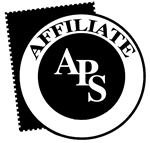Using Beecher And Wawrukiewicz For U.N. Scott 102-103 Commercial Covers
(Published: May, 2015, Volume 15, Number 2, Issue #38) (Table Of Contents)(Author: Larry Fillion)
This article will rate some commercial covers originating from the United Nations New York office with Scott 102 and 103 on the covers.
The United Nations postage rates are identical to those of the host nation, so in this case, they are the same as the United States.
Similar to the
Using Beecher And Wawrukiewicz For U.S. Scott 1194 Commercial Covers
(Published: November, 2010, Volume 10, Number 2, Issue #31) article, the Beecher And Wawrukiewicz book will be used.
At this point, the Third Edition has been published and this new edition will be used.
By rating covers, one can determine if the correct postage was used and also determine if the cover was sent surface or airmail and if registered, how much coverage was paid for.
There will be another article written in a future MIASMA which will deal with foreign covers/postcards and use a different book also written by Beecher And Wawrukiewicz.
Below is the image of the cover of "U.S. Domestic Postal Rates, 1872-2011 - Third Edition" written by Henry W. Beecher and Anthony S. Wawrukiewicz:
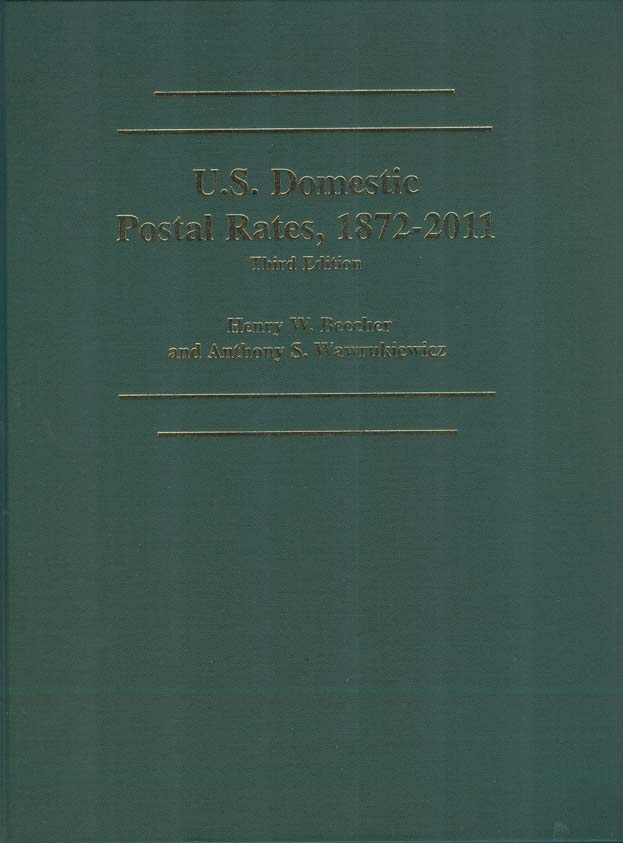
The cover below is dated December 8, 1962. It is franked with the 4¢ Anti-Malaria stamp and was sent to Brooklyn, NY. In Beecher and Wawrukiewicz, the first chapter is titled 'First-Class, Letter, Surface'. On page 9, there is a table for the rates for first class letters. From August 1, 1958 until January 6, 1963, covers weighing less than one ounce was 4¢.
Surface Rate: August 1, 1958 until January 6, 1963
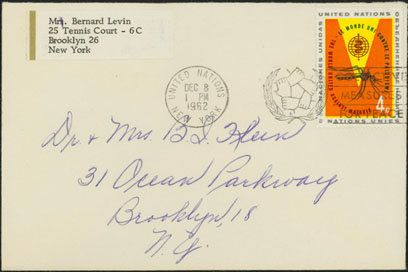
The cover below was sent to Altadena, California and is dated April 17, 1962. The large "VIA AIR MAIL" auxiliary marking is evidence that it was sent airmail and also the cover has 15¢ worth of postage applied. In Beecher and Wawrukiewicz, there is another chapter titled 'First-Class, Letter, Airmail'. The chart on page 87 specifies the airmail rate of 8¢ was in effect from August 1, 1958 till January 6, 1963.
Airmail Rate: August 1, 1958 till January 6, 1963
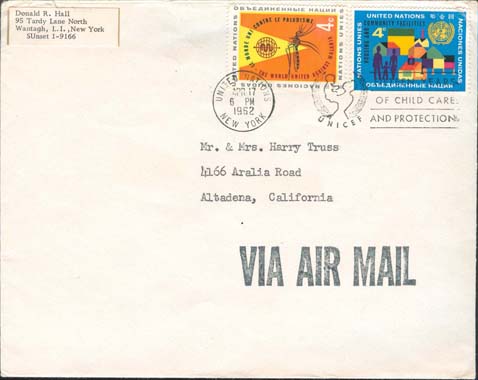
The cover below was sent to Yakima, Washington. This cover was sent Third-Class. Third-Class mail was established in 1863. This class of single-piece third-class mail was used to send printed matter, circulars, and transient rate newspapers. Determining third-class mail can sometimes be easy because the postmarks are usually "dumb". "Dumb" postmarks mean there is no date, usually no month and day, and many times, no year. The third-class rate was 4¢ for less than 2 oz. from January 7, 1963 till January 6, 1968. The chapter "Third-Class, Single Piece" starts on page 153.
3rd Class Rate: January 7, 1963 till January 6, 1968
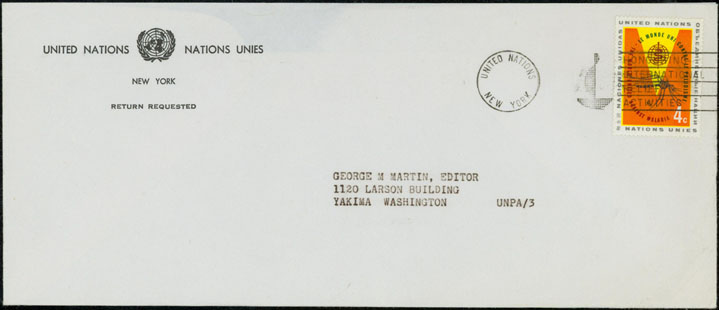
The postcard below, postmarked August 16, 1963, was sent to Vienna, Virginia. It looks like it might be overpaid because 4¢ was paying the first class letter rate earlier in the year. There is a chapter in Beecher and Wawrukiewicz titled "First-Class, Postal and Post Cards, and Stamped Cards" and on page 51, there is a table that has a rate of 4¢ from January 7th, 1963 until January 6th, 1968 so any postcards you find with the 4¢ Anti-Malaria stamp on it during this time frame are worth keeping.
Postcard Rate: January 7th, 1963 until January 6th, 1968
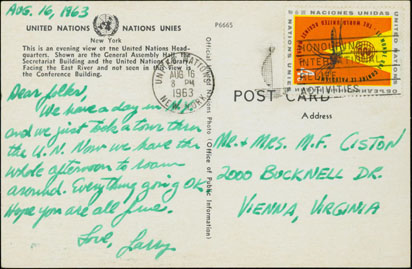
In Beecher and Wawrukiewicz, there is another chapter titled "Certified Mail Service". This service is added on to either surface or airmail letters/postcards and the fee is on top of what is needed for postage. Certified mail provides the mailer with a mailing receipt and a record of delivery at the office of address. The table on page 325 states that from July 1, 1957 till March 35, 1966, the service fee was 20¢. The total postage paid was 25¢ and the other 5¢ paid for first class surface letter rate from From January 7, 1963 till January 6, 1968.
Certified Cover sent 05/24/1963
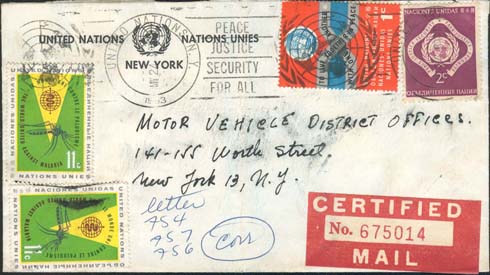
This July 2, 1963 manilla envelope was sent by J. & H. STOLOW, Inc. to Moticello, NY. It is customary for the postal authority to apply cancellations on Registered covers where the covers are sealed (in this case the back) in order to show that the envelope/package was sealed when it was initially received at the sending post office. There is also a July 3, 1963 receiving cancellation on the back (the one in the middle) which was applied at the Moticello, NY post office when it was received there. Chapter 36 in Beecher And Wawrukiewicz is titled "Registry Service" and there is a table with the fees. Eight 11¢ anti-malaria stamps (Scott 103) and a 2¢ (Scott 3) paying a total of 90¢. 75¢ paid for the $10.01 to $100 indemnity which leaves 15¢ paying for the triple weight (3 ounces) cover at 5¢ per ounce.
Registered Letter (front), 75¢ registration fee, 15¢ triple weight cover
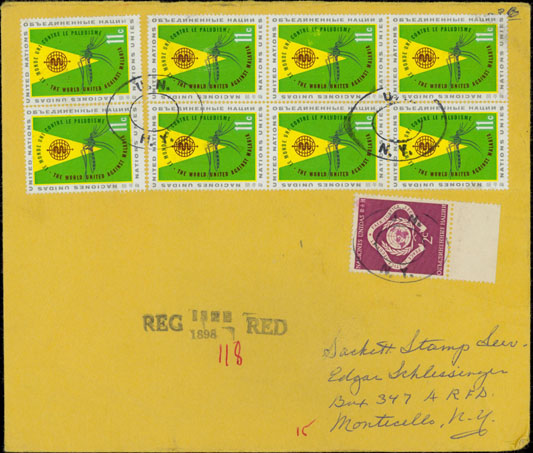
Registered Letter (back), 75¢ registration fee, 15¢ triple weight cover
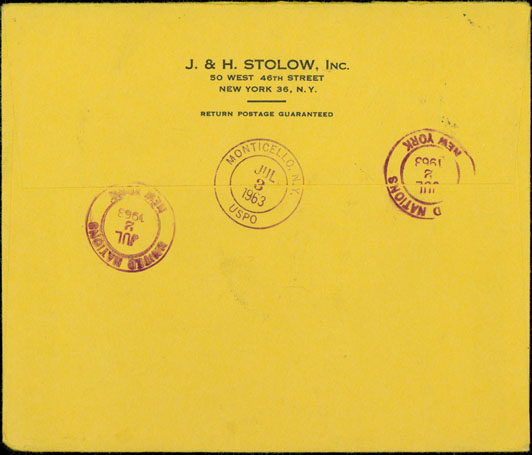
*If any reader has other commercial covers with Scott U.N. 102-103 with different domestic rates, please contact me at malariastamps@yahoo.com
By rating covers, one can determine if the correct postage was used and also determine if the cover was sent surface or airmail and if registered, how much coverage was paid for.
There will be another article written in a future MIASMA which will deal with foreign covers/postcards and use a different book also written by Beecher And Wawrukiewicz.
Below is the image of the cover of "U.S. Domestic Postal Rates, 1872-2011 - Third Edition" written by Henry W. Beecher and Anthony S. Wawrukiewicz:

The cover below is dated December 8, 1962. It is franked with the 4¢ Anti-Malaria stamp and was sent to Brooklyn, NY. In Beecher and Wawrukiewicz, the first chapter is titled 'First-Class, Letter, Surface'. On page 9, there is a table for the rates for first class letters. From August 1, 1958 until January 6, 1963, covers weighing less than one ounce was 4¢.
Surface Rate: August 1, 1958 until January 6, 1963

The cover below was sent to Altadena, California and is dated April 17, 1962. The large "VIA AIR MAIL" auxiliary marking is evidence that it was sent airmail and also the cover has 15¢ worth of postage applied. In Beecher and Wawrukiewicz, there is another chapter titled 'First-Class, Letter, Airmail'. The chart on page 87 specifies the airmail rate of 8¢ was in effect from August 1, 1958 till January 6, 1963.
Airmail Rate: August 1, 1958 till January 6, 1963

The cover below was sent to Yakima, Washington. This cover was sent Third-Class. Third-Class mail was established in 1863. This class of single-piece third-class mail was used to send printed matter, circulars, and transient rate newspapers. Determining third-class mail can sometimes be easy because the postmarks are usually "dumb". "Dumb" postmarks mean there is no date, usually no month and day, and many times, no year. The third-class rate was 4¢ for less than 2 oz. from January 7, 1963 till January 6, 1968. The chapter "Third-Class, Single Piece" starts on page 153.
3rd Class Rate: January 7, 1963 till January 6, 1968

The postcard below, postmarked August 16, 1963, was sent to Vienna, Virginia. It looks like it might be overpaid because 4¢ was paying the first class letter rate earlier in the year. There is a chapter in Beecher and Wawrukiewicz titled "First-Class, Postal and Post Cards, and Stamped Cards" and on page 51, there is a table that has a rate of 4¢ from January 7th, 1963 until January 6th, 1968 so any postcards you find with the 4¢ Anti-Malaria stamp on it during this time frame are worth keeping.
Postcard Rate: January 7th, 1963 until January 6th, 1968

In Beecher and Wawrukiewicz, there is another chapter titled "Certified Mail Service". This service is added on to either surface or airmail letters/postcards and the fee is on top of what is needed for postage. Certified mail provides the mailer with a mailing receipt and a record of delivery at the office of address. The table on page 325 states that from July 1, 1957 till March 35, 1966, the service fee was 20¢. The total postage paid was 25¢ and the other 5¢ paid for first class surface letter rate from From January 7, 1963 till January 6, 1968.
Certified Cover sent 05/24/1963

This July 2, 1963 manilla envelope was sent by J. & H. STOLOW, Inc. to Moticello, NY. It is customary for the postal authority to apply cancellations on Registered covers where the covers are sealed (in this case the back) in order to show that the envelope/package was sealed when it was initially received at the sending post office. There is also a July 3, 1963 receiving cancellation on the back (the one in the middle) which was applied at the Moticello, NY post office when it was received there. Chapter 36 in Beecher And Wawrukiewicz is titled "Registry Service" and there is a table with the fees. Eight 11¢ anti-malaria stamps (Scott 103) and a 2¢ (Scott 3) paying a total of 90¢. 75¢ paid for the $10.01 to $100 indemnity which leaves 15¢ paying for the triple weight (3 ounces) cover at 5¢ per ounce.
Registered Letter (front), 75¢ registration fee, 15¢ triple weight cover

Registered Letter (back), 75¢ registration fee, 15¢ triple weight cover

*If any reader has other commercial covers with Scott U.N. 102-103 with different domestic rates, please contact me at malariastamps@yahoo.com

